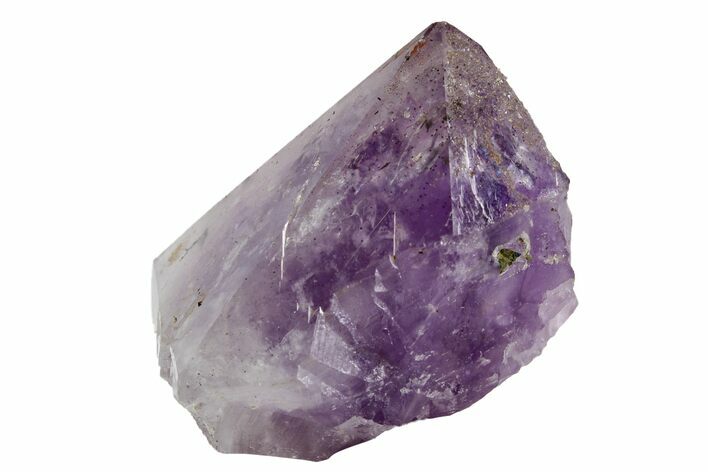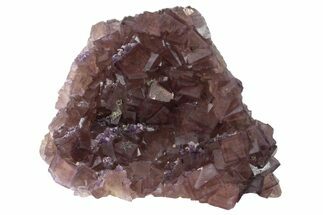This Specimen has been sold.
1.5" Thunder Bay Amethyst Crystal with Hematite Inclusions - Canada
This is an amethyst crystal with small hematite and pyrite inclusions, collected from the Purple Mountain Mine near Thunder Bay, Ontario. This specimen comes with an acrylic display base and mineral tack.
In the 1950s, amethyst deposits were discovered about 30 miles northeast of Thunder Bay, Ontario while building a road. It has been mined in the area since the 1960s. This material can range from light, delicate purple to almost black in color. One very distinctive characteristic of many Thunder Bay amethyst crystals is the inclusion of red hematite as microscopic disks or spherules within the crystals. These inclusions can cause crystals to have red highlights, zones, or even appear completely red in color.
Amethyst is a purple variety of quartz (SiO2) that owes its violet color to natural irradiation, iron impurities, and the presence of trace elements, resulting in complex crystal lattice substitutions. It is considered a semi-precious gemstone, and just two centuries ago was considered to have a value on par with diamonds, sapphires, and rubies. The largest and best known amethyst deposits occur in volcanic formations in southern Brazil and Uruguay, but many localities around the world produce an amazing variety of amethyst crystals and formations.
Amethyst is a purple variety of quartz (SiO2) that owes its violet color to natural irradiation, iron impurities, and the presence of trace elements, resulting in complex crystal lattice substitutions. It is considered a semi-precious gemstone, and just two centuries ago was considered to have a value on par with diamonds, sapphires, and rubies. The largest and best known amethyst deposits occur in volcanic formations in southern Brazil and Uruguay, but many localities around the world produce an amazing variety of amethyst crystals and formations.
About Quartz
Quartz is the name given to silicon dioxide (SiO2) and is the second most abundant mineral in the Earth's crust. Quartz crystals generally grow in silica-rich environments--usually igneous rocks or hydrothermal environments like geothermal waters--at temperatures between 100°C and 450°C, and usually under very high pressure. In either case, crystals will precipitate as temperatures cool, just as ice gradually forms when water freezes. Quartz veins are formed when open fissures are filled with hot water during the closing stages of mountain formation: these veins can be hundreds of millions of years old.
Quartz is the name given to silicon dioxide (SiO2) and is the second most abundant mineral in the Earth's crust. Quartz crystals generally grow in silica-rich environments--usually igneous rocks or hydrothermal environments like geothermal waters--at temperatures between 100°C and 450°C, and usually under very high pressure. In either case, crystals will precipitate as temperatures cool, just as ice gradually forms when water freezes. Quartz veins are formed when open fissures are filled with hot water during the closing stages of mountain formation: these veins can be hundreds of millions of years old.
About Pyrite
The mineral pyrite, also known as iron pyrite, is commonly referred to as Fool's Gold because its metallic luster and pale brass-yellow hue give it a superficial resemblance to gold. In the old mining days, pyrite was sometimes mistaken for gold.
It is the most common of the sulfide minerals with the chemical formula FeS2. Pyrite crystals occur in many shapes and habits, including cubes of all sizes, penetration twin cubes, pyritohedral clusters and as small druzy crystals that can exhibit a beautiful glistening effect.
The mineral pyrite, also known as iron pyrite, is commonly referred to as Fool's Gold because its metallic luster and pale brass-yellow hue give it a superficial resemblance to gold. In the old mining days, pyrite was sometimes mistaken for gold.
It is the most common of the sulfide minerals with the chemical formula FeS2. Pyrite crystals occur in many shapes and habits, including cubes of all sizes, penetration twin cubes, pyritohedral clusters and as small druzy crystals that can exhibit a beautiful glistening effect.
SPECIES
Quartz var. Amethyst & Hematite
LOCATION
Purple Mountain Mine, Thunder Bay, Ontario, Canada
SIZE
1.5" wide
CATEGORY
SUB CATEGORY
ITEM
#164352
 Reviews
Reviews













